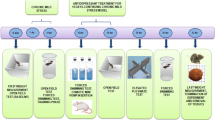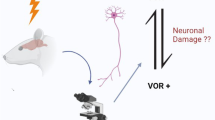Abstract
Depression is associated with hippocampus (HC) volume loss. Chronic mild stress (CMS) in rats is a model of depression. Antidepressants attenuate HC volume loss and reverse the depression-like symptoms of stressed animals. We evaluated the effect of CMS and the selective serotonin reuptake inhibitor, fluoxetine (FLX) treatment on behavioral and cognitive parameters in rats, and on HC and frontal cortex (FC) neurotrophic factors levels. Male rats were exposed sequentially, over a period of 5 weeks, to a variety of mild stressors. FLX (5 mg/kg/day ip) was administered to the stressed group and controls (unstressed). After 5 weeks of CMS, animals were tested using the Morris Water Maze (MWM). In the MWM, we observed that FLX had a transitory effect on unstressed rats. CMS reduced insulin-like growth factor-1 receptor (IGF-1R) levels in the HC whereas after FLX treatment these levels reverted to normal range. CMS rats revealed a significant decrease in extracellular signal-regulated kinase (ERK) phosphorylation in both HC and FC regions, while FLX normalized these levels. This study suggests that IGF-1R and ERK may have a role in mediating the neural stress response and the mode of action of FLX. This role seems to be independent of the BDNF alterations.








Similar content being viewed by others
References
Aberg ND, Brywe KG, Isgaard J (2006) Aspects of growth hormone and insulin-like growth factor-I related to neuroprotection, regeneration, and functional plasticity in the adult brain. Sci World J 6:53–80
Adachi M, Barrot M, Autry AE, Theobald D, Monteggia LM (2008) Selective loss of brain-derived neurotrophic factor in the dentate gyrus attenuates antidepressant efficacy. Biol Psychiatry 63:642–649
Banegas I, Prieto I, Alba F, Vives F, Araque A, Segarra AB, Durán R, de Gasparo M, Ramírez M (2005) Angiotensinase activity is asymmetrically distributed in the amygdala, HC and prefrontal cortex of the rat. Behav Brain Res 156(2):321–326
Bremner JD, Narayan M, Anderson ER, Staib LH, Miller HL, Charney DS (2000) Hippocampal volume reduction in major depression. Am J Psychiatry 157:115–118
Cai L, Yan XB, Chen XN, Meng QY, Zhou JN (2010) Chronic all-trans retinoic acid administration induced hyperactivity of HPA axis and behavioral changes in young rats. Eur Neuropsychopharmacol 20(12):839–847
Campbell S, McQueen G (2004) The role of the hippocampus in the pathophysiology of major depression. J Psychiatry Neurosci 29:417–426
Castren E (2004) Neurotrophic effects of antidepressant drugs. Curr Opin Pharmacol 4:58–64
Choy KH, de Visser Y, Nichols NR, van den Buuse M (2008) Combined neonatal stress and young-adult glucocorticoid stimulation in rats reduce BDNF expression in hippocampus: effects on learning and memory. Hippocampus 18:655–667
De Foubert G, Carney SL, Robinson CS, Destexhe EJ, Tomlinson R, Hicks CA, Murray TK, Gaillard JP, Deville C, Xhenseval V, Thomas CE, O’Neill MJ, Zetterström TS (2004) Fluoxetine-induced change in rat brain expression of brain-derived neurotrophic factor varies depending on length of treatment. Neurosci 128:597–604
De Saint Blanquat P, Hok V, Alvernhe A, Save E, Poucet B (2010) Tagging items in spatial working memory: a unit-recording study in the rat medial prefrontal cortex. Behav Brain Res 209(2):267–273
Detanico BC, Piato ÂL, Freitas JJ, Lhullier FL, Hidalgo MP, Caumo W, Elisabetsky E (2009) Antidepressant-like effects of melatonin in the mouse chronic mild stress model. Eur J Pharmacol 607(1–3):121–125
Duman RS, Monteggia LM (2006) A neurotrophic model for stress-related mood disorders. Biol Psychiatry 59:1116–1127
Gamaro GD, Prediger ME, Lopes J, Bassani MG, Dalmaz C (2008) FLX alters feeding behavior and leptin levels in chronically-stressed rats. Pharmacol Biochem Behav 90:312–317
Glowinski J, Iversen LL (1966) Regional studies of catecholamines in the rat brain I. The disposition of [3H]norepinephrine, [3H]dopamine and [3H]dopa in various regions of the brain. J Neurochem 13:655–669
Gouirand AM, Matuszewich L (2005) The effects of chronic unpredictable stress on male rats in the water maze. Physiol Behav 86:21–31
Gourley SL, Wu FJ, Kiraly DD, Ploski JE, Kedves AT, Duman RS, Taylor JR (2008) Regionally specific regulation of ERK MAP kinase in a model of antidepressant-sensitive chronic depression. Biol Psychiatry 63:353–359
Grønli J, Bramham C, Murison R, Kanhema T, Fiske E, Bjorvatn B, Ursin R, Portas CM (2006) Chronic mild stress inhibits BDNF protein expression and CREB activation in the dentate gyrus but not in the hippocampus proper. Pharmacol Biochem Behav 85:842–849
Grunbaum-Novak N, Taler M, Gil-Ad I, Weizman A, Cohen H, Weizman R (2008) Relationship between antidepressants and IGF-1 system in the brain: possible role in cognition. Eur Neuropsychopharmacol 18:431–438
Harmer CJ, Bhagwagar Z, Cowen PJ, Goodwin GM (2002) Acute administration of citalopram facilitates memory consolidation in healthy volunteers. Sychopharmacology (Berl) 163:106–110
Harris RBS, Zhou J, Youngblood BD, Smagin GN, Ryan DH (1997) Failure to change exploration or saccharin preference in rats exposed to chronic mild stress. Physio Behav 63(1):91–100
Hayley S, Poulter MO, Merali Z, Anisman H (2005) The pathogenesis of clinical depression: stressor- and cytokine-induced alterations of neuroplasticity. Neurosci 135:659–678, Review
Herrera-Guzmán I, Gudayol-Ferré E, Herrera-Guzmán D, Guàrdia-Olmos J, Hinojosa-Calvo E, Herrera-Abarca JE (2009) Effects of selective serotonin reuptake and dual serotonergic-noradrenergic reuptake treatments on memory and mental processing speed in patients with major depressive disorder. J Psychiatr Res 43:855–863
Hoshaw BA, Malberg JE, Lucki I (2005) Central administration of IGF-I and BDNF leads to long-lasting antidepressant-like effects. Brain Res 1037:204–208
Huang GJ, Herbert J (2006) Stimulation of neurogenesis in the hippocampus of the adult rat by fluoxetine requires rhythmic change in corticosterone. Biol Psychiatry 59:619–624
Jacobs BL, van Praag H, Gage FH (2000) Adult brain neurogenesis and psychiatry: a novel theory of depression. Mol Psychiatry 5:262–269
Johnson-Farley NN, Patel K, Kim D, Cowen DS (2007) Interaction of FGF-2 with IGF-1 and BDNF in stimulating Akt, ERK, and neuronal survival in hippocampal cultures. Brain Res 18(1154):40–49
Kar S, Chabot JG, Quirion R (1993) Quantitative autoradiographic localization of [125I]insulin-like growth factor I, [125I]insulin-like growth factor II, and [125I]insulin receptor binding sites in developing and adult rat brain. J Comp Neurol 333:375–397
Kato T (2007) Molecular genetics of bipolar disorder and depression. Psychiatry Clin Neurosci 61:3–19, Review
LeRoith D, McGuinness M, Shemer J, Stannard B, Lanau F, Faria TN, Kato H, Werner H, Adamo M, Roberts CT Jr (1992) Insulin-like growth factors. Biol Signals 1:173–181
Levshina IP, Shuikin NN (2002) Peculiarities of exploration behavior of socially deprived rats in stress situation. Zh Vyssh Nerv Deiat Im I P Pavlova 52:602–608
Li S, Wang C, Wang W, Dong H, Hou P, Tang Y (2008) Chronic mild stress impairs cognition in mice: from brain homeostasis to behavior. Life Sci 82:934–942
Malberg E, Eisch AJ, Nestler EJ, Duman RS (2000) Chronic antidepressant treatment increases neurogenesis in adult rat hippocampus. J Neurosci 20:9104–9110
Mato S, Vidal R, Castro E, Díaz A, Pazos A, Valdizán EM (2010) Long-term fluoxetine treatment modulates cannabinoid type 1 receptor-mediated inhibition of adenylyl cyclase in the rat prefrontal cortex through 5-hydroxytryptamine 1A receptor-dependent mechanisms. Mol Pharmacol 77(3):424–434
Mattson MP, Maudsley S, Martin B (2004) A neural signaling triumvirate that influences ageing and age-related disease: insulin/IGF-1, BDNF and serotonin. Ageing Res Rev 3:445–464
Mebratu Y, Tesfaigzi Y (2009) How ERK1/2 activation controls cell proliferation and cell death: is subcellular localization the answer? Cell Cycle 8(8):1168–1175
Meneses A (2002) Tianeptine: 5-HT uptake sites and 5-HT(1–7) receptors modulate memory formation in an autoshaping Pavlovian/instrumental task. Neurosci Biobehav Rev 26:309–319
Molteni R, Calabrese F, Bedogni F, Tongiorgi E, Fumagalli F, Racagni G, Riva MA (2006) Chronic treatment with fluoxetine up-regulates cellular BDNF mRNA expression in rat dopaminergic regions. Int J Neuropsychopharmacol 9:307–317
Moreau JL, Scherschlicht R, Jenck F, Martin JR (1995) Chronic mild stress-induced anhedonia model of depression; sleep abnormalities and curative effects of electroshock treatment. Behav Pharmacol 6:682–687
Musazzi L, Milanese M, Farisello P, Zappettini S, Tardito D, Barbiero VS, Bonifacino T, Mallei A, Baldelli P, Racagni G, Raiteri M, Benfenati F, Bonanno G, Popoli M (2010) Acute stress increases depolarization-evoked glutamate release in the rat prefrontal/frontal cortex: the dampening action of antidepressants. PLoS One 5(1):e8566
Nagai T, Takuma K, Kamei H, Ito Y, Nakamichi N, Ibi D, Nakanishi Y, Murai M, Mizoguchi H, Nabeshima T, Yamada K (2007) Dopamine D1 receptors regulate protein synthesis-dependent long-term recognition memory via extracellular signal-regulated kinase 1/2 in the prefrontal cortex. Learn Mem 14:117–125
Naudon L, Hotte M, Jay TM (2007) Effects of acute and chronic antidepressant treatments on memory performance: a comparison between paroxetine and imipramine. Psychopharmacol (Berl) 191:353–364
Pham TM, Soderstrom S, Henriksson BG, Mohammed AH (1997) Effect of neonatal stimulation on later cognitive function and hippocampal nerve growth factor. Behav Brain Res 86:113–120
Pinnock SB, Lazic SE, Wong HT, Wong IH, Herbert J (2009) Synergistic effects of dehydroepiandrosterone and fluoxetine on proliferation of progenitor cells in the dentate gyrus of the adult male rat. Neuroscience 158:1644–1651
Qi X, Lin W, Li J, Pan Y, Wang W (2006) The depressive-like behaviors are correlated with decreased phosphorylation of mitogen-activated protein kinases in rat brain following chronic forced swim stress. Behav Brain Res 175:233–240
Qi X, Lin W, Li J, Li H, Wang W, Wang D, Sun M (2008) Fluoxetine increases the activity of the ERK-CREB signal system and alleviates the depressive-like behavior in rats exposed to chronic forced swim stress. Neurobiol Dis 31:278–285
Rodrigues SM, Schafe GE, LeDoux JE (2004) Molecular mechanisms underlying emotional learning and memory in the lateral amygdala. Neuron 44:75–91
Schmidt HD, Duman RS (2007) The role of neurotrophic factors in adult hippocampal neurogenesis, antidepressant treatments and animal models of depressive-like behavior. Behav Pharmacol 18:391–418, Review
Sheline YI, Gado MH, Kraemer HC (2003) Untreated depression and hippocampal volume loss. Am J Psychiatry 160:1516–1518
Skolnick P (1999) Antidepressants for the new millennium. Eur J Pharmacol 375:31–40
Song L, Che W, Min-Wei W, Murakami Y, Matsumoto K (2006) Impairment of the spatial learning and memory induced by learned helplessness and chronic mild stress. Pharmacol Biochem Behav 83:186–193
Sun CY, Qi SS, Lou XF, Sun SH, Wang X, Dai KY, Hu SW, Liu NB (2006) Changes of learning, memory and levels of CaMKII, CaM mRNA, CREB mRNA in the hippocampus of chronic multiple-stressed rats. Chin Med J (Engl) 119:140–147
Tacke U (1989) Fluoxetine: an alternative to the tricyclics in the treatment of major depression? Am J Med Sci 298:126–129
Taler M, Bar M, Korob I, Lomnitski L, Baharav E, Grunbaum-Novak N, Weizman A, Gil-Ad I (2008) Evidence for an inhibitory immunomodulatory effect of selected antidepressants on rat splenocytes: possible relevance to depression and hyperactive-immune disorders. Int Immunopharmacol 8:526–533
Torres-Aleman I (1999) Insulin-like growth factors as mediators of functional plasticity in the adult brain. Horm Metab Res 31:114–119
Trejo JL, Piriz J, Llorens-Martin MV, Fernandez AM, Bolós M, LeRoith D, Nuñez A, Torres-Aleman I (2007) Central actions of liver-derived insulin-like growth factor I underlying its pro-cognitive effects. Mol Psychiatry 12:1118–1128
Willner P (1997) Validity, reliability and utility of the chronic mild stress model of depression: a 10-year review and evaluation. Psychopharmacology 134:319–329
Willner P (2005) Chronic mild stress (CMS) revisited: consistency and behavioral- neurobiological concordance in the effects of CMS. Neuropsychobiology 52:90–110
Willner P, Towell A, Sampson D, Sophokleus S, Muscant R (1987) Reduction of sucrose preference by chronic unpredictable mild stress, and its restoration by a tricyclic antidepressant. Psychopharmacology (Berl) 93:358–364
Yau JL, Noble J, Hibberd C, Rowe WB, Meaney MJ, Morris RG, Seckl JR (2002) Chronic treatment with the antidepressant amitriptyline prevents impairments in water maze learning in aging rats. J Neurosci 22:1436–1442
Author information
Authors and Affiliations
Corresponding author
Rights and permissions
About this article
Cite this article
First, M., Gil-Ad, I., Taler, M. et al. The Effects of Fluoxetine Treatment in a Chronic Mild Stress Rat Model on Depression-Related Behavior, Brain Neurotrophins and ERK Expression. J Mol Neurosci 45, 246–255 (2011). https://doi.org/10.1007/s12031-011-9515-5
Received:
Accepted:
Published:
Issue Date:
DOI: https://doi.org/10.1007/s12031-011-9515-5




